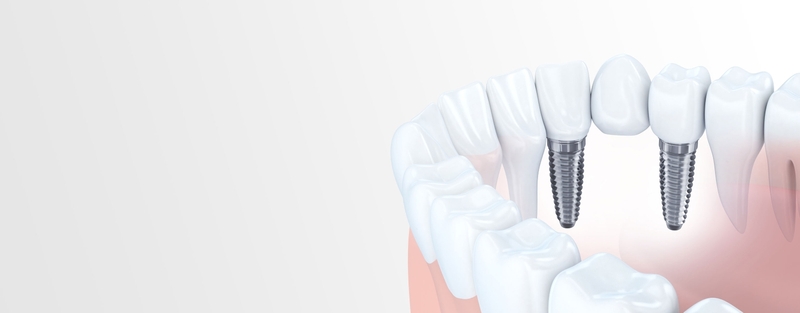Implants & Bridges
At SF Dental, we can offer you many state-of-the-art options when it comes to tooth replacement.
About the author, Dr. Stella Kim
The materials on this page were prepared and medically reviewed by Dr. Stella Kim, DDS, a San Francisco dentist and a graduate of the UCSF School of Dentistry.
Our philosophy at SF Dental is to save your existing teeth whenever possible. However, there are situations when a tooth will need to be removed and replaced with an artificial alternative.
Two of the most common replacement options are dental bridges and implants. Here, we’ll discuss the differences and well as why you might choose one method over the other.
Dental bridges
It typically takes two or three appointments to install a dental bridge, and the procedure is as follows:
- We prepare the natural teeth on either side of the gap to be filled. This process is similar to preparing for crowns: we remove any decayed material and shape the teeth to accommodate the abutment crowns.
- Next, we take very precise impressions of your teeth and gums for the lab. The lab uses these impressions to create the pontics (fake teeth) and abutments (anchoring crowns on adjacent teeth to the empty space) for your bridge.
- You will receive a temporary bridge to protect your teeth while the permanent bridge is being made in the lab. The manufacturing process takes about 2-3 weeks.
- Once your bridge is ready, you’ll come back into the office and the permanent bridge will be placed, adjusted, and cemented into place.
Dental implants
When we talk about dental implants, it is important to understand that there are several components involved:
- Fixture: The titanium post that is inserted into the jaw bone and that acts as a replacement for the root.
- Abutment: Once the fixture is integrated successfully in the bone, which takes several months, it can receive an abutment that will link the implant fixture to the restoration of choice.
- Restoration: Typically, a crown, bridge, or denture is attached to the abutment. The process for installing a crown over the dental implant requires several appointments. It follows this basic pattern:
- Evaluation and grafting: If an unrestorable tooth is being removed, often a bone graft will be placed to reduce bone shrinkage at the implant site and to maximize the likelihood of implant success. If the tooth has been previously lost long before the implant surgery, the bone area will be evaluated to see whether or not a bone graft is needed.
- Fixture placement: The titanium post is implanted into the jaw. A gum graft may also be performed to promote proper healing, depending on the specifics of your situation. For front teeth, we can provide a temporary removable device such as a flipper or an essix retainer to cover the missing space, for a cosmetic purposes. These temporary devices are not meant to be functional for chewing food and must be removed while eating.
- Bone integration: We then need to wait for the jaw to heal and the implant fixture to finish integrating into the bone. This usually takes at least two to three months, but it can take longer, depending on your particular situation. It is important to give the bone and other tissues to sufficiently rebuild around the implant, otherwise further complications can occur.
- Impressions prepared: Once the implant fixture is integrated into the bone and has stabilized, it is now ready to be restored. We place a tool called an impression coping on the implant fixture, which allows us to accurately align the position of the implant in relation to your natural teeth. We then take accurate impressions of the gums around the implant, the implant coping, and the surrounding teeth. These impressions are sent to the lab for the construction of your custom abutment and crown.
- Restoration: On delivery day, we remove all the temporary components and replace them with the custom abutment and crown. We then check your bite and the contacts with adjacent teeth, as well as the fit along the gums.
Hybrid options: implant-supported dentures
In addition to traditional dental bridges and implant-supported crowns, a third option combines these two procedures, for situations where large numbers of teeth need to be replaced.
Instead of placing implant fixtures for each tooth, the fixtures can be placed strategically at key points, and the dental bridge is then fabricated to connect to each of these posts. The bridge may span as few as three teeth, or the entire arch can be replaced if the patient is missing many teeth.
Why do I need to replace missing teeth?
Missing teeth are more than just a source of embarrassment, they can have a serious impact on your entire oral health. These are some of the key reasons to replace missing teeth, even if they’re in the back of your mouth where most people don’t see them:
- Alterations to speech: Missing teeth can make your speech sound strange, creating difficulties with pronunciation.
- Changes to your bite: Over time, missing teeth can affect how the rest of the teeth share the pressures from chewing food and/or from clenching teeth. This can create dysfunctions that wear down your other teeth or cause cracks and fractures.
- Bone loss in the jaw: As with anything in the body, it’s “use it or lose it” when it comes to your jawbone. Missing teeth cause the jaw to lose bone density, which can lead to jaw injuries, pain, and increased dental complications. It can also lead to a condition called pneumatization of the posterior superior maxillary sinus, if the upper back teeth have been missing for too long. This can complicate implant surgery, sometimes making it impossible, due to the fact that bone between the oral cavity and the maxillary sinus has thinned too much.
- Shifting teeth: The teeth next to the space where your missing tooth used to be will slowly start to move to fill in the gap. This can lead to major orthodontic issues and a loss of chewing functionality.
- Headaches and jaw pain: All of the above changes in the structure of your mouth can lead to more frequent headaches or jaw pain.
How do I choose between bridges and implants?
In many cases, the specifics of your situation will dictate what the right solution is, and we’ll go over treatment options during your appointment at SF Dental. Not everyone is a good candidate for implants or bridges.
However, if both options are viable, here are some factors that may play a role in your decision:
- Cost and insurance coverage: Dental implants are usually the more expensive solution, especially if you are replacing multiple teeth, and not all insurance plans cover them.
- Treatment time: Start to finish, it’s usually faster to install a bridge than a dental implant.
- Durability: Dental implants are usually considered a permanent solution, whereas bridges will need to be adjusted and possibly replaced periodically, usually once every 5-10 years.
- Bone density: Successful implant treatment requires you to have sufficient bone density in the jaw. If the density is too low, it is sometimes possible to improve it with bone grafting, but this increases the time it takes to set and heal your abutment.
- Effects on other teeth: Placing a bridge requires us to alter the natural teeth on either side of the bridge. With an implant, no other teeth are affected.
- Comfort: Most people find dental implants to be the most comfortable and natural-feeling of the two solutions.
- Upkeep: Your brushing and flossing routine doesn’t need to change all that much with an implant. However, with a bridge, you will need to learn to clean around the bridge apparatus and prevent food from building up around it.
Further reading
- Aetna, Inc. (2013). Implant-Supported Denture.
- Gaviria L, et al. (2014). “Current trends in dental implants.” KAOMS.
- Jinfeng L, et al. (2017). “The Pneumatization and Adjacent Structure of the Posterior Superior Maxillary Sinus and Its Effect on Nasal Cavity Morphology.” Medical Science Monitor.
- Mayo Clinic Staff. (2018). Dental implant surgery.
- Sharma A, et al. (2012). “Assessment of various factors for feasibility of fixed cantilever bridge: A review study.” ISRN Dentistry.


